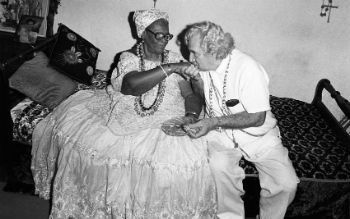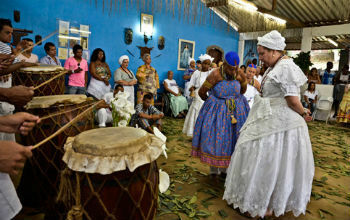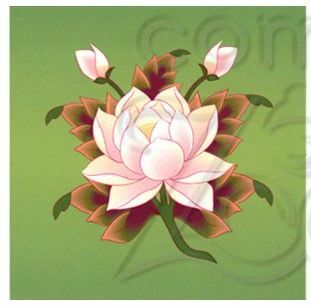O Candomblé it is a monotheistic religion that believes in the existence of the soul and in the afterlife.
The word “candomblé” means “dance” or “dance with drums” and worships the orixás, usually revered through dances, songs and offerings.
Differences between Candomblé and Umbanda
| Candomblé | Umbanda |
|---|---|
| strong hierarchy | The hierarchy is not so rigid |
| 5000 years of existence | Founded in the 20th century |
| Performs animal sacrifices in specific ceremonies | Does not perform animal sacrifices |
| There is only incorporation of entities, but the orixá does not speak, does not consult, only gives the axé (blessing). Only the saint's father and/or mother give advice and consultations through Ifá, from the búzios. | It incorporates incarnated entities, that is: spirits that have already lived on earth. These give inquiries and advice directly to the customer. There is no incorporation of the orixá. |
| Being the father and/or mother of saints is equivalent to the Catholic priesthood. Therefore, it is difficult for them to have an ordinary life, as there are a series of food, clothing and attitude restrictions. | The priest does not need to dedicate himself exclusively to Umbanda. |
| To support themselves, Candomblé houses charge for work performed. | Does not charge for services. |
History of Candomblé in Brazil

Jorge Amado, writer, kisses the hand of Mãe Menininha do Gantois, considered the greatest saint-mother in Brazil
Candomblé is the practice of African beliefs brought to Brazil by enslaved people. Therefore, it is not an African religion, but an Afro-Brazilian one.
Therefore, the history of Candomblé is mixed with that of Catholicism. Forbidden to continue with their religion, the slaves used the images of the saints to escape the censorship imposed by the Church. This explains the syncretism found in Candomblé in Brazil, something that is not found in Africa.
Nowadays, however, many Candomblé houses do not accept syncretism and seek to return to their African origins. Likewise, in the Brazilian version, we have a mixture of orixás from various regions of the African continent.
This is due to the fact that the blacks who landed to be slaves were from various parts of Africa. Each Orixá represents a force or personification of nature and also a people or a nation
Candomblé, as a religious practice, gained clear contours in Bahia in the mid-18th century and defined itself during the 20th century. Currently, there are millions of practitioners throughout Brazil, reaching more than 1.5% of the national population.
In order to preserve this heritage of African culture, Federal Law 6292, of December 15, 1975, made certain Candomblé terreiros a material or immaterial heritage subject to registration.
Candomblé Rituals

Aspect of a Candomblé ceremony
The Candomblé rituals are, as a rule, performed through chants, dances, drum beats, offerings of vegetables, minerals, objects and, at times, the sacrifice of some animals.
Participants must wear specific costumes with the colors and guides of their orixá, and each one has its own day, color, objects and specific foods, suited to their ritual.
A ritual can bring together tens to hundreds of people, varying according to the size of the house that performs obligations and parties. On these occasions, there is great concern with hygiene and nutrition, as everything must be purified to be worthy of the orixá.
Usually, Candomblé rituals are practiced in houses, gardens or terreiros, which can be of matriarchal, patriarchal or mixed lineage. Therefore, the celebrations are led by the "father or mother of saint" or "babalorixá" and "iyalorisha" respectively.
It should be noted that the succession of these spiritual leaders is hereditary. However, there may be disputes in the succession, which often ends up leading to the closure of the terreiro.
Finally, it is worth remembering that Candomblé adepts take seven years to complete the initiation within the stipulated precepts.
Orixás of Candomblé

Some of the Orixás worshiped in Candomblé
The Orixás are entities that represent the energy and force of nature. They play a fundamental role in the cult when they are incorporated by more experienced practitioners.
They have specific personalities, skills, ritual preferences and natural phenomena, which give them distinct qualities and strengths.
The unique God of Candomblé may vary according to the African region of origin. For the Ketu it is Olorum, for the Bantus it is Nzambi and for the Jeje it is Mawu.
There are hundreds of Orixás, however, the most revered in Brazil are:
eshu
| Meaning | ball |
|---|---|
| Day of the week | Monday |
| Colors | red (active) and black (knowledge absorption) |
| Salutation | Laroiê (Salve Exu) |
| Instrument | seven irons attached to the same base, facing upwards |
ogun
| Meaning | war (gun) |
|---|---|
| Day of the week | Tuesday |
| Color | dark blue (the color of metal when heated in the forge) |
| Salutation | Ogunhê, hello, Ogun |
| Instrument | iron sword |
Oxossi
| Meaning | night Hunter (oxo, Hunter; ossi, night) |
|---|---|
| Day of the week | Thursday |
| Color | turquoise blue (color of the sky at the beginning of the day) |
| Salutation | The Kiarô! ("okaaro" means good morning, in the Yoruba language) |
| Instrument | ofa (bow and arrow) |
Shango
| Meaning | the one who stands out by force |
|---|---|
| Day of the week | Wednesday |
| Colors | red (active), white (peace), brown (the earth) |
| Salutation | Kaô Kabiesile; come see it born on the ground |
| Instrument | oxé (double-bladed stone axe) (Oyá) |
iansan
| Meaning | nine (she had nine children) |
|---|---|
| Day of the week | wednesday (or monday) |
| Colors | red (active and fire) or brown (the earth) |
| Salutation | And I stopped! - Hi! Joyful and cheerful or What a beautiful sword! |
| Instrument | iruexim (iron cable or copper with a ponytail) |
Oxum
| Meaning | river that passes through Oxogbo, Nigerian city |
|---|---|
| Day of the week | Saturday |
| Color | golden (yellow) |
| Salutation | Hey, oh!; play in the waters |
| Instrument | baby (mirror) |
oba
| Meaning | Queen |
|---|---|
| Day of the week | Wednesday |
| Color | red |
| Salutation | Oba xirê! - powerful queen, strong |
| Instrument | dagger |
logum
| Meaning | acclaimed prince (Ode, relationship with Ogun and It's from, connection with Oxossi) |
|---|---|
| Day of the week | Thursday |
| Colors | turquoise and yellow (gold) |
| Salutation | Loci, Loci, Logum! Shout your war cry, warrior prince! |
| Instrument | ofa (bow and arrow) and abebe (mirror) |
Nana
| Meaning | originally nené/nana/nanã |
|---|---|
| Day of the week | Tuesday |
| Colors | lilac or white streaked with blue |
| Salutation | Saluba Nanã! - Hail, owner of the pot of Earth! |
| Instrument | ibiri (kind of cane) |
obaluaê
| Meaning | king, lord of the land |
|---|---|
| Day of the week | Monday |
| Colors | white (peace and healing), black (knowledge) and/or red (activity) |
| Salutation | Atoto! Oto, Silence! |
| Instrument | xaxará (kind of magic stick) |
Ossaim
| Meaning | divine light |
|---|---|
| Day of the week | tuesday (or thursday) |
| Colors | green (healing) and white (peace) |
| Salutation | Me, I bake! - Oh, leaves! |
| Instrument | seven-pointed metal rod, with a pigeon in the center |
Oxumaré
| Meaning | the one that moves with the rain |
|---|---|
| Day of the week | Tuesday |
| Colors | yellow (knowledge) and green (health) |
| Salutation | Aruboboí! - gbogbo, continuous |
| Instrument | metal snake |
Yemanja
| Meaning | iya, means mother; omo, son; and eja, fish |
|---|---|
| Day of the week | Saturday |
| Colors | white and blue (translucent crystal) |
| Salutation | It hurts! (odo, river) |
| Instrument | baby (mirror) |
hopefully
| Meaning | White light (oh, light; and alas, white) |
|---|---|
| Day of the week | Friday |
| Color | White |
| Salutation | Oops, Nanny! - Hail, father! |
| Instrument | paxoro (kind of staff) |
Ibeji/Eres
| Meaning | ib means born; and eji, two |
|---|---|
| Day of the week | Sunday |
| Colors | all |
| Salutation | Beje eró! - Call them both! |
| Instrument | There is not |
read more:
- Orixás do Brasil
- Religious intolerance
- African culture
- Afro-Brazilian Culture
- Syncretism

